Multilayered Continuous and Dense Canopy Allowing Little Light Penetration
Learninsta presents the core concepts of Biology with high-quality research papers and topical review articles.
Concept of Biome and Their Distribution
Biomes are large regions of earth that have similar or common vegetation and climatic conditions. They play a crucial role in sustaining life on Earth. They are defined by their soil, climate, flora and fauna. Biomes have distinct biological communities that have been formed in response to a shared physio-chemical climate. Biomes are seen to even spread across continents. Thus, it can be observed that a biome is a broader term than habitat.
Any biome can comprise a variety of habitats. Factors such as temperature, light, water availability determine what type of organisms and adaptations are observed in a biome (Fig. 10.4).
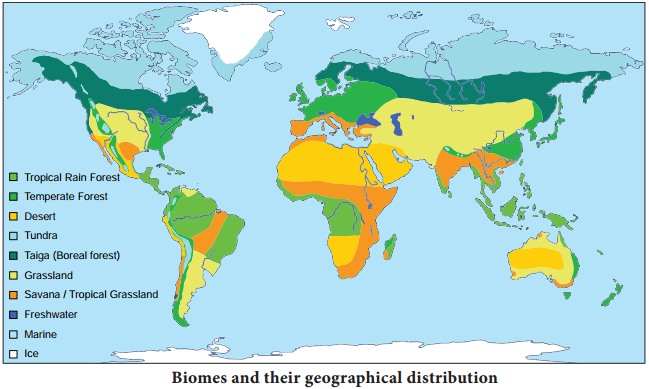
Characters of a biome
- Location, Geographical position (Latitude, Longitude)
- Climate and physiochemical environment.
- Predominant plant and animal life.
- Boundaries between biomes are not always sharply defined. Transition or transient zones are seen as in case of grassland and forest biomes (Fig. 10.5).
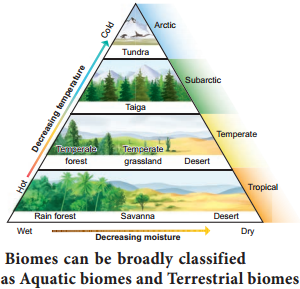
Aquatic Biomes
They occupy about 71% of the biosphere. The aquatic biome is home to millions of aquatic organisms like fishes. The climate of coastal zones are inflenced by aquatic bodies.
Aquatic biomes of earth
- Freshwater (Lakes, ponds, rivers)
- Brackish water (Estuaries / Wetlands)
- Marine (Coral reefs, pelagic zones and abyssal zones)
Terrestrial biomes
These are large communities of plants and animals that occupy a distinct region. They include grassland, tundra, desert, tropical rainforest, and deciduous and coniferous forests. Terrestrial biomes are distinguished primarily by their predominant vegetation, and are mainly determined by climate, which in turn, determines the organisms inhabiting them.
These include the keystone species and indicator species which are unique to their respective biomes. The terrestrial biomes are a source of food, O2 and act as CO2 sink, apart from the climate regulatory role.
Major Biomes of the Earth
Tundra biome, Taiga biome, Grassland biome, Alpine biome, Forest biome and Desert biome.
TUNDRA BIOME
- This is the almost treeless plain in the northern parts of Asia, Europe and North America.
- Winters are long with little daylight, Summers are short, with long daylight hours.
- Precipitation is less than 250 mm per year. It is a zone of permafrost.
- Dwarf willows, birches, mosses, grasses, sedges are the flora here.
- Reindeer, arctic hare, musk ox, lemmings are important Tundra herbivores. Some important carnivores are the arctic fox, arctic wolf, bobcat and snowy owl. Polar bears live along coastal areas.
- Because of the severe winters, many of the animals are migratory. For example, the many shore birds and waterfowl such as ducks and geese, nest in the Tundra during the summer and migrate south for the winter.
TAIGA BIOME
- The Taiga is 1300-1450 km wide zone south of the Tundra.
- This area has long and cold winters.
- Summer temperature ranges from 10°C to 21°C.
- Precipitation ranges about 380-1000 mm annually.
- The Taiga is a forest of coniferous trees such as spruce, fir and pine. This is a major source for the logging industry.
- Important migratory herbivores include moose, elk, deer and reindeer. Moose and reindeer migrate to the Taiga for winter and to the Tundra for summers.
- The common smaller mammals are herbivorous squirrels, snowshoe hare and predatory pine martens. Important predators include the timber wolf, grizzly bear, black bear, bobcat and wolverines. (Fig. 10.6)
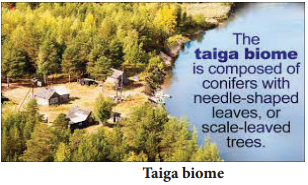
GRASSLAND BIOME
- Grasslands occur in temperate and in the tropical regions.
- They have hot summers, cold winters, and irregular rainfall.
- Often they are characterized by high winds.
- The low irregular rainfall is the factor which makes the difference between a temperate deciduous forest and a temperate grassland.
- Herbivores like antelope, bison, wild horse, jack rabbit, ground squirrel and prairie dogs are abundant.
- Predators include coyotes, foxes, hawks and snakes.
- In India, fauna of grasslands includes Elephant, Gaur, Rhino, Antelope.
- Flora of grasslands include purple needle grass, wild oats, foxtail, ryegrass and buffalo grass (Fig. 10.7).
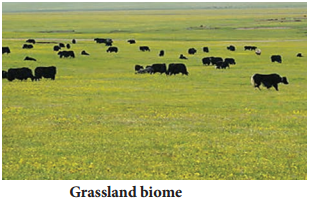
Alpine biome
- The alpine zone (zone between timber line and snow zone) includes in the descending order, a sub-snow zone immediately below the snow zone, a meadow zone in the centre and a shrub zone which gradually merges into the timber zone.
- The snow zone of Himalayas lies over 5100m above mean sea level and alpine zone exists at a height of 3600m. From an ecological view point, the zone above the limits of tree growth (timber line) exhibits extreme environmental conditions which greatly influence the biota of this region.
- Alpine zone of Himalayas is characterized by sparseness of animal groups. Many invertebrates of alpine zone are predatory and occur in lakes, streams and ponds. Among fishes, amphibians and vertebrates are totally lacking and reptilian fauna is greatly impoverished.
- Flora of alpines includes alpine phacelia, bear grass, bristlecone pine, moss campion, polylepis forest, pygmy bitterroot, and wild potato.
Forest biomes
Forest is a broad term used to describe areas where there are a large number of trees (Fig. 10.8). The forest biomes include a complex assemblage of diffrent kinds of biotic communities. The major forest biomes are the Tropical forests and the Temperate forests.
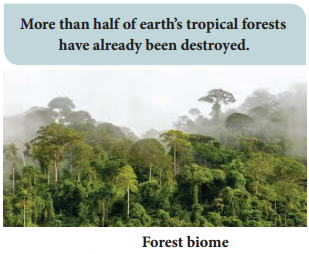
Tropical forest
- They occur near the equator (between latitudes 23.5° at north and 23.5° at south).
- The major characteristic of tropical forests is their distinct seasons. Only two seasons are present (rainy and dry). Winter is absent. The length of daylight is about 12 hours and varies little.
- The average annual temperature ranges between 20°C and 25°C.
- Precipitation is evenly distributed throughout the year with annual rainfall exceeding 2000 mm.
- Soil is nutrient-poor and acidic. Decomposition is rapid and soils are subject to heavy leaching.
- Tree canopy is multilayered and continuous, allowing little light penetration.
- Flora is highly diverse: one square kilometer may contain as many as 100 different tree species. Trees are 25-35 m tall, with buttressed trunks and shallow roots, mostly evergreen, with large dark green leaves. Common vegetation are orchids, bromeliads, vines (lianas), ferns, mosses, and palms.
- They are characterized by the greatest diversity of fauna which includes birds, bats, small mammals, and insects.
Temperate forest
- These forests occur in eastern North America, northeastern Asia and western and central Europe.
- Have well-defined seasons with a distinct winter. Moderate climate and a growing season of 140-200 days during 4-6 frostfree months distinguish temperate forests.
- Annual temperature varies from – 30° C to 30° C.
- Precipitation (750-1500 mm) is distributed evenly throughout the year.
- Soil is fertile, enriched with decaying litter.
- Canopy is moderately dense and allows light to penetrate, resulting in well-developed and richly diversified understorey vegetation and stratification of animals.
- Flora is characterized by 3-4 tree species per km2. Trees have broad leaves that are lost annually such as oak, hickory, beech, hemlock, maple, basswood, cottonwood, elm, willow, and spring-flowering herbs.
- Fauna consists of squirrels, rabbits, skunks, birds, deer, mountain lion, bobcat, timber wolf, fox, and black bear.
Desert biomes
- Deserts cover about one fit of the earth's surface and occur where rainfall is >500 mm/year.
- Rainfall is usually very low and/or concentrated in short bursts between long rainless periods. Evaporation rates regularly exceed rainfall rates.
- Soils are course-textured, shallow, rocky or gravely with good drainage and have no subsurface water. The finer dust and sand particles are blown elsewhere, leaving heavier pieces behind. Sand dunes are common.
- Mean annual temperatures range from 20-25°C. The extreme maximum ranges from 43.5 – 49° C. Minimum temperatures sometimes drop to -18°C. Based on the temperature range, deserts can be Hot deserts and Cold deserts.
- Hot deserts such as the Sahara of North Africa and the deserts of the southwestern U.S., Mexico, Australia and India (Thar desert) occur at low latitudes.
- Hot deserts have a considerable amount of specialized vegetation (xerophytes), aloe, agave, Opuntia species, Euphorbia royleana as well as specialized vertebrate and invertebrate animals.
- The dominant animals of warm deserts are reptiles and small mammals. The Indian Spiny-tailed lizard, the blackbuck, the white-footed fox are the common fauna of the Thar deserts. There are also insects, arachnids and birds.
- Cold deserts occur in Antarctic, Greenland and the Nearctic realm, parts of USA and in parts of western Asia and the Ladakh region in India.
- Widely distributed animals are jack rabbits, kangaroo rats, kangaroo mice, pocket mice, grasshopper mice, antelope and ground squirrels.
Source: https://www.learninsta.com/concept-of-biome-and-their-distribution/
Kommentar veröffentlichen for "Multilayered Continuous and Dense Canopy Allowing Little Light Penetration"